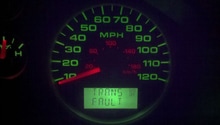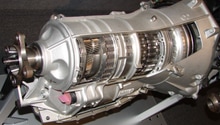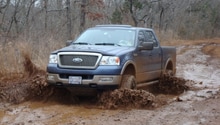F-150/F-250: Why Won't My Transmission Shift?
There you are, sitting at a stop sign on a deserted highway, when suddenly your transmission won't shift into gear. Before you panic, check out our handy step-by-step guide on how to diagnose and fix a transmission that won't shift.
This article applies to the F-150 and F-250 Super Duty (2004 - 2014)
Transmissions are complicated and expensive, which generally means it's time to worry when they won't shift. Before running off to the mechanic or RockAuto for a rebuild, check out this step-by-step guide on how to diagnose and fix a transmission that won't shift.
Step 1 – Check to see which transmission the truck has
Check the door jamb sticker in the F-150 or F-250 Super Duty to figure out all sorts of information about the truck, including which transmission it has. The code for your transmission should appear in the circled area indicated in Figure 1. Your sticker might not look exactly like this, but the format should generally be the same.
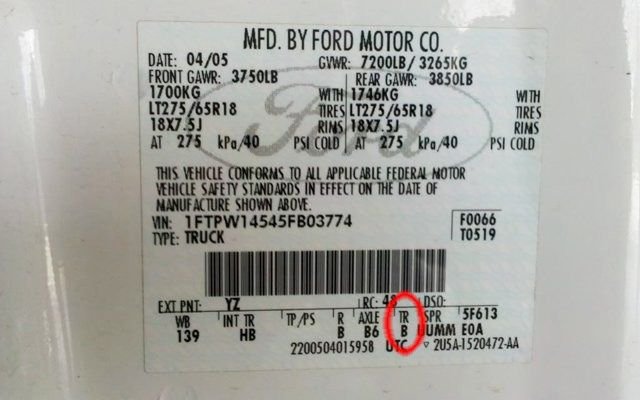
| F-150 Transmission Codes | F-250 Super Duty Transmission Codes |
|---|---|
| Q - 4-speed automatic, (4R75E) | 2 - 5-speed manual, TREMEC (TR4050) |
| 6 - 6-speed automatic, (6R80) | P - 6-speed automatic (6R140) |
| Q - 4-speed automatic, 4R75E (F-150/Mark LT) | T - 5-speed automatic (5R110W) |
| M - 5-speed manual, M5R2-C (F-150) | W - 6-speed automatic (6R140) diesel |
| F - 4-speed automatic, 4R75E (Mark LT) | 5 - 6-speed manual, Dana (Z/F S6-650) |
| A - 4-speed automatic, 4R70E (F-150) | 7 - 6-speed manual, Dana (Z/F M6HD-W), diesel |
| B - 5-speed automatic (5R110W), Hi-Torque, diesel | |
| T - 5-speed automatic (5R110W) |
Step 2 – Check for transmission codes
Turn the truck off and look at the instrument panel. Keep your OBD II code reader handy.
- If the O/D light is flashing, go to the O/D light diagnostic.
- If you're getting a trans fault error, pull codes with your reader to see what is wrong.
- If you have no lights, move on to step 2.
Related Article:
- Why is My Transmission Fault Light On? - Ford-Trucks.com
4R75E DTCs for Slipping Transmission
| Diagnostic Trouble Code | Failing Component | Cause for Code | Symptoms |
|---|---|---|---|
| P0102, P0103, P1100, P1101 | Mass Air Flow Sensor (MAF) | The Mass Air Flow sensor in your truck isn't working correctly, causing the transmission to misbehave | Incorrect reading from the MAF could result in all sorts of transmission weirdness. Soft shifting, hard shifting, odd shift points, etc. |
| P0705, P0708 | Transmission Range sensor (TR) | TR Circuit failure | Harsh shifts. Stuck in D or 2. |
| P0712, P0713 | Transmission Fluid Temperature (TFT) | 712 = sensor circuit grounded 713 = sensor circuit open |
Hard shifting. |
| P0715, P0717, P0718 | Turbine Shaft Speed Sensor (TSS) | Signal from TSS dead, intermittent, on noisy | Hard shifts |
| P0720, P0721, P0722 | Output Shaft Sensor (OSS) | Signal from OSS dead, intermittent, on noisy | Hard shifting, abnormal shifting, slipping, |
| P0731, P0732, P0733, P0734, | Shift Solenoid A/B | Shift Solenoid A/B failure or internal transmission failure | No gear in 1, 2, 3, 4 (respectively) |
| P1714, P1715 | Shift Solenoid A/B | 4 = SSA mechanical failure 5 = SSB mechanical failure |
Solenoid is either stuck closed or open due to a physical failure. Replace them. |
| P0740, P0743 | Torque Converter Clutch (TCC) | TCC solenoid is failing or TCC is slipping excessively. | Transmission Warning light may flash. Engine might stall in D at low speeds or never engage. |
| P0741 | TCC | TCC is slipping excessively due to internal, mechanical issues. | Slipping transmission |
| P0748, P0963 | Electronic Pressure Control sensor (EPC) | EPC solenoid short | Limited torque, slipping transmission, or harsh shifting if the circuit is stuck open. |
| P1728 | Transmission Slip Error | Truck computer senses excessive slipping | Transmission is slipping, TCC operating erratically |
| P1740 | TCC | TCC solenoid mechanical failure | Stalls in D and 2, or torque converter never applies |
| P1741 | TCC | Excessive TCC engagement issue | Engine rushing/oscillation in 3rd gear. TCC is slipping |
| P1742, P1743 | TCC, internal issues | TCC solenoid has failed, or the TCC itself has failed | Hard shifting |
| P1744 | TCC | Truck senses extra slippage from the TCC | Slipping transmission |
| P0962, P1747 | EPC | EPC solenoid malfunctioning (short circuit) | Minimum EPC pressure, reduced torque, slippage |
| P1760 | EPC | EPC solenoid signal dead | Reduction in torque |
6R80 DTCs for Slipping Transmission
| Diagnostic Trouble Code | Failing Component | Cause for Code | Symptoms |
|---|---|---|---|
| P0715, P0716, P0717 | Turbine Shaft Speed Sensor (TSS) | short circuit, noisy or lost signal, no signal | May cause Check Engine Light, will trigger Transmission Warning Light, inability to shift from 3rd, hard shifts, "slipping" transmission/No TCC engagement |
| P0720, P0721, P0722, P0723 | OSS Sensor | short circuit, noisy or lost signal, no signal | Check Engine Light, hard shifts, "slipping" transmission/No TCC engagement |
| P0731, P0732, P0733, P0734, P0735, P0729 | Transmission error | 1 = 1st gear 2 = 2nd gear 3 = 3rd gear 4 = 4th gear 5 = 5th gear 29 = 6th gear |
Missing gear. Engine flare in missed gear, hard shifts, TCIL |
| P0740, 1 | TCC | circuit failure, circuit open | Slipping shifts, harsh shifts, no shifts, Triggers "Limp home mode," Transmission Warning light, and maybe Check Engine Light. |
|
P0781, P0782, P0783, P0784, P0729 |
Shift Errors | 1 = D1-2 2 = D2-3 3 = D3-4 4 = D4-5 29 = D5-6 |
These codes indicate shifting errors. You may be stuck in gear and have strange shifting from one gear to another. |
| P0960, P0961, P0962, P0963 | Line Pressure Control Solenoid | The line pressure control solenoid is shorting out. | Hard shifts, Transmission Warning Message. |
Pro Tip
If your truck is throwing codes that aren't listed here, you can figure them out by bringing your truck to a local auto parts store. More than likely they'll pull your codes for free. Or, invest in a service manual for your particular year, make and model of Ford.
Step 3 – Check your transmission fluid
Pull the dipstick, let it drip, and check for a burnt smell or discoloration in the fluid.
- If secured and the light goes off, you have solved your problem.

Step 4 – Check selector lever linkage
Check for binding of the line or other obstructions. If damaged, replace. Doing this yourself can be challenging for folks who never work on their car. The price for parts and labor isn't horrendous, so it might be worth it to just take it to the shop.
- If your truck has trouble shifting into other gears, or other shift lever weirdness, it might need some adjustment.
- The Transmission Range Sensor might be damaged. If it is, your truck should give you a check engine light. Replace it if necessary.
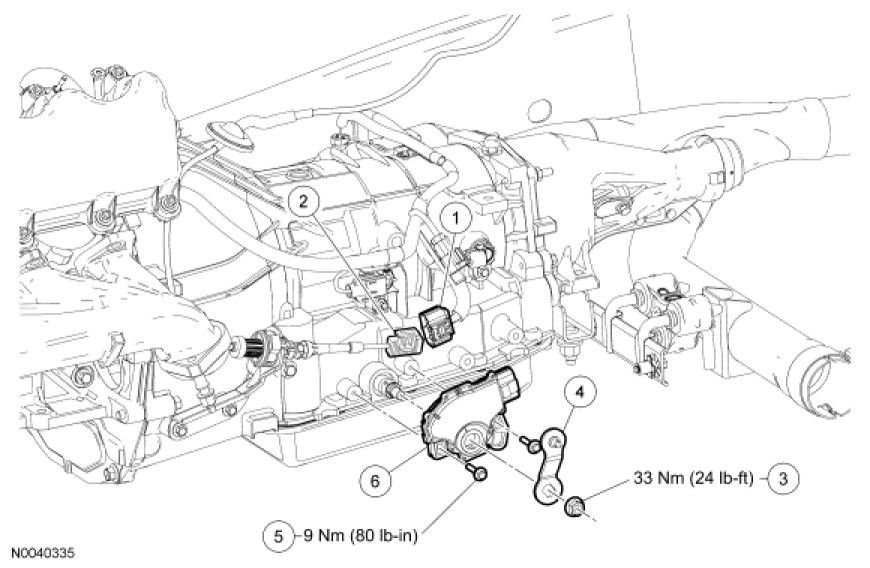
Step 5 - Pull transmission pan and filter
Remove transmission fluid pan and pull transmission filter. Look for clogs and other damage.
- If there are chunks of metal in your transmission pan, you have a broken transmission problem.
- If clogged or dirty, replace. You can remove the transmission pan by unbolting it. Read the article linked below for a more in-depth walkthrough.
Related Article:
- How to Change Your Transmission Fluid - Ford-Trucks.com

Related Discussions and Sites
- Shift Lever Jumped a Spot? - F150online.com
- How to Replace Transmission Range Sensor - F150online.com
- How to Replace/Adjust Transmission Range Sensor Without Tool - Youtube.com
- Overheated Transmission Loses Reverse Gear - F150online.com
- Transmission Pan and Filter Removal - F150Forum.com


